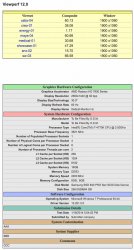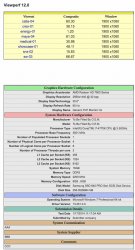The specviewperf tests tells only half the story, and namely the opengl(or if you want display potency) of the cards. But here is the bigger part of this: the COMPUTING PERFORMANCE. If you look at the numbers, Apple ditched the opengl performance a bit(the memory amount and clock speed) BUT KEPT THE COMPUTATIONAL POWER OF THE CARDS. The d500 is actually close match to w8000 at compute power and d700 close match to w9000. d300 more close to w7000. This is of great importance since w7000 is close in performance to nvidia k5000, a very expensive card. If software will use opencl more and more(let's hope) this counts much more then pure opengl capabilities of the cards(witch is better bang for your buck on amd anyway). So yes, they are pro cards(for visual part of the story) but also they have great opencl capabilities. If you try to run fluid simulations or pyro fx in Houdini(for example) witch can take advantage of multiple cards, then you will see the true advantage. The question is, how many software packages take advantage of this NOW? FCX is one, maybe Houdini for it's fluids and pyro fx(if side fx updates they MACOS distro maybe even more so), but don't know for others(Mari from what i heard?). Anyway, a pair of w9000 fire pro's will cost you an arm and a leg, so if you DO have an app that take advantage of this dual setup, then it's a great deal to take the dual d700(or let's face it even d500 - w8000). Let's wait and see where and when the software producers move on this, but i think i will budget one of this babies for next iteration.






